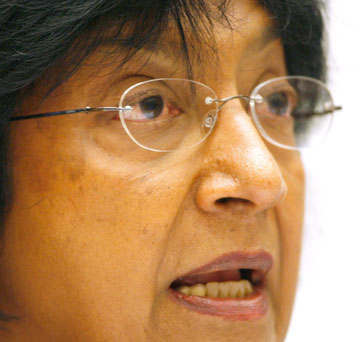OHCHR: Serious Violations in Sri Lanka
by Office of the High Commissioner for Human Rights, March 13, 2009
|
Even after the Government's announcement on 24 February that heavy weapons would no longer be fired into the no-fire zones, close to 500 people were reportedly killed and more than a thousand injured in these zones. Of these deaths, the great majority have been attributed to the use of heavy weapons. Overall, since 20 January, more than two thirds of the reported deaths and injuries have occurred in the no-fire zones. |
Serious violations of international law committed in Sri Lanka conflict: UN human rights chief
13 March 2009
GENEVA (OHCHR) -- The UN High Commissioner for Human Rights Navi Pillay expressed her growing alarm Friday at the increasing number of civilians reported killed and injured in the conflict in northern Sri Lanka, and at the apparent ruthless disregard being shown for their safety.
"Certain actions being undertaken by the Sri Lankan military and by the LTTE may constitute violations of international human rights and humanitarian law." Pillay said. "We need to know more about what is going on, but we know enough to be sure that the situation is absolutely desperate. The world today is ever sensitive about such acts that could amount to war crimes and crimes against humanity."
 Despite the Government's designation of safe -- or "no-fire" -- zones for civilians, repeated shelling has continued inside those zones, according to information made available to OHCHR. Other areas holding civilians have also been shelled. OHCHR said a range of credible sources have indicated that more than 2,800 civilians may have been killed and more than 7,000 injured since 20 January, many of them inside the no-fire zones. The casualties are believed to include hundreds of children killed and more than a thousand injured. Despite the Government's designation of safe -- or "no-fire" -- zones for civilians, repeated shelling has continued inside those zones, according to information made available to OHCHR. Other areas holding civilians have also been shelled. OHCHR said a range of credible sources have indicated that more than 2,800 civilians may have been killed and more than 7,000 injured since 20 January, many of them inside the no-fire zones. The casualties are believed to include hundreds of children killed and more than a thousand injured.
Even after the Government's announcement on 24 February that heavy weapons would no longer be fired into the no-fire zones, close to 500 people were reportedly killed and more than a thousand injured in these zones. Of these deaths, the great majority have been attributed to the use of heavy weapons. Overall, since 20 January, more than two thirds of the reported deaths and injuries have occurred in the no-fire zones.
According to UN estimates, a total of 150,000 to 180,000 civilians remain trapped in an ever-shrinking area of territory in the Vanni region.
"The current level of civilian casualties is truly shocking, and there are legitimate fears that the loss of life may reach catastrophic levels, if the fighting continues in this way," the High Commissioner said. "Very little attention is being focused on this bitter conflict."
The Liberation Tigers of Tamil Eelam (LTTE) are reported to be continuing to hold civilians as human shields, and to have shot at civilians trying to leave the area they control. They are also believed to have been forcibly recruiting civilians, including children, as soldiers.
"The brutal and inhuman treatment of civilians by the LTTE is utterly reprehensible, and should be examined to see if it constitutes war crimes," said Pillay.
There is very limited food – and reports of severe malnutrition – and key medical supplies, such as sutures, painkillers and antibiotics for treating victims, are virtually unavailable, even in the one makeshift medical facility still functioning.
The High Commissioner called on both the Sri Lankan Government and the LTTE to immediately suspend hostilities in order to allow the evacuation of the entire civilian population by land or sea. She also urged the Sri Lankan Government to grant full access to UN and other independent agencies to allow an accurate assessment of the human rights and humanitarian conditions in the conflict zone.
|
 Home
Home Archives
Archives Despite the Government's designation of safe -- or "no-fire" -- zones for civilians, repeated shelling has continued inside those zones, according to information made available to OHCHR. Other areas holding civilians have also been shelled. OHCHR said a range of credible sources have indicated that more than 2,800 civilians may have been killed and more than 7,000 injured since 20 January, many of them inside the no-fire zones. The casualties are believed to include hundreds of children killed and more than a thousand injured.
Despite the Government's designation of safe -- or "no-fire" -- zones for civilians, repeated shelling has continued inside those zones, according to information made available to OHCHR. Other areas holding civilians have also been shelled. OHCHR said a range of credible sources have indicated that more than 2,800 civilians may have been killed and more than 7,000 injured since 20 January, many of them inside the no-fire zones. The casualties are believed to include hundreds of children killed and more than a thousand injured.